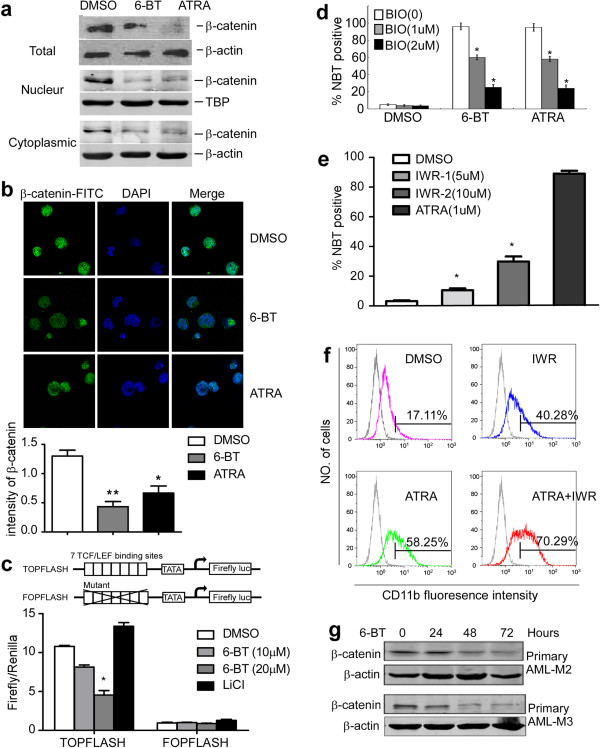Figure 3.

Reduced activity of canonical Wnt signaling upon 6-BT and ATRA treatment. a. Westernblot analysis showed that β-catenin expression in HL-60 cells was reduced by both 6-BT and ATRA treatment. β-actin as an endogenous control. Westernblot analysis of β-catenin in subcellular fractions in HL-60 cells after treatment by DMSO (0.01%), 6-BT (10 μM) or ATRA (1 μM) for 3 days. β-actin was used as cytoplasmic control and TBP was used as nuclear protein loading control. b. HL-60 cells were treated with DMSO (0.01%), 6-BT (10 μM) or ATRA (1 μM) for 3 days and then were fixed in 4% formaldehyde/PBS and permeabilized with 0.5% Triton X-100. β-catenin was visualized by immunofluorescence (green, left panel). The DNA-intercalating dye DAPI was used to identify cell nuclei (blue, center panel). The right panel presents a merged image to highlight the nuclear pool of β-catenin. c. Histogram showing TOPFLASH and FOPFLASH activation in HL-60 cells treated with DMSO, 6-BT or LiCl. *P <0.05. d. NBT reduction assay showed that BIO, which could up-regulate β-catenin protein, could partly abolish 6-BT- or ATRA-induced differentiation of HL-60 cells. Data are from three independent experiments. *P <0.05. e. HL-60 cells were treated with DMSO, IWR-1 (5 μM and 10 μM) and ATRA (1 μM,as a positive control) for 3 days, differentiation was assessed by NBT reduction. Data are from three independent experiments. *P <0.05. f. HL-60 cells were treated for 3 days with IWR-1 (10 μM), ATRA (0.5 μM) or both and then the cells were stained with anti-CD11b antibodies and analyzed by fluorescence-activated cell sorting (FACS). g. Westernblot analysis showed reduced expression of β-catenin in primary AML-M3 and AML-M2 leukemic blasts treated with 6-BT (10 μM) for 24, 48 or 72 hours.
